A thick crust of bird droppings is piled on the gilded balustrade of one of Britain's most expensive properties. Pigeon skeletons lie among shattered mirrors and water streams through broken cornicing. This is The Tower, a £30m palace in "Billionaires Row" in north London whose spectacular ruin has been kept secret until now.
It is one of 10 mansions in the middle of The Bishops Avenue – the heart of London's spiralling property market – that have stood almost entirely vacant since they were bought a quarter of a century ago, it is believed on behalf of members of the Saudi Arabian royal family. Their Grecian columns are cracking into pieces and mosaic-tiled swimming pools are filled with rubble. Nature has taken over to the extent that owls have moved in.
It is a desolate scene repeated up and down the supposedly prestigious avenue that Lloyds Bank has calculated is the second most expensive street in Britain. While more and more people struggle to get on to London's property ladder as house prices rise at 11.2% a year, the Guardian has established that 16 mansions on the most expensive stretch of The Bishops Avenue are sitting empty, many behind padlocked gates, with their windows shuttered with steel grilles and overgrown grounds patrolled by guard dogs.
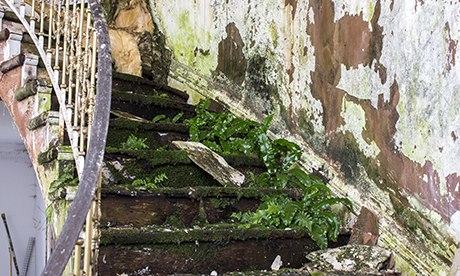 The Towers on The Bishops Avenue Photograph: Graeme Robertson
The Towers on The Bishops Avenue Photograph: Graeme Robertson
Across the street from the former Saudi properties stands another derelict mansion worth £18m with smashed windows and walls coated in anti-climb paint. Metal grilles block the windows of another believed to belong to a Middle Eastern owner through a Channel Islands company which has been "sold on behalf of receivers" for £20m.
But that doesn't stop the prices going up. Dryades, a mansion until recently owned by a Pakistani politician, sold for £12m in 2007 and is believed to be worth about £30m today. Heath Lodge, the scene of the 1984 murder by silver bullet of fashion tycoon Aristos Constantinou, is worth £13m today after having been sold in the late 1970s for £400,000.
The dereliction can be agonising for people struggling to keep a roof above their heads in one of the world's most expensive cities. One security guard working on the avenue said he had only recently been homeless and it was exasperating to see so many tens of thousands of square feet of property – enough to house dozens of people – falling apart. "How do you let something like this go to waste?" he said. "You wouldn't, would you?"
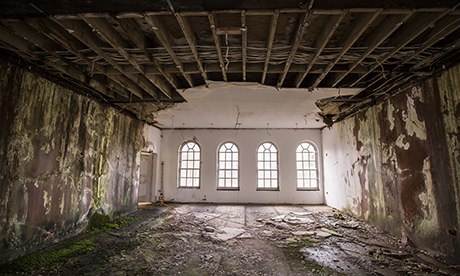 The The Towers on The Bishops Avenue Photograph: Graeme Robertson
The The Towers on The Bishops Avenue Photograph: Graeme Robertson
Over the last half a century this curving road near Hampstead Heath has become a haven for the winners and losers of numerous geopolitical shocks. Royals flushed with oil wealth from Nigeria and Saudi Arabia were among the first to come. Iranians fled here after the fall of the shah. Now Chinese househunters are following Russians and Kazakhs who have spent millions securing an address estate agents tell them is as world famous as the Champs Elysées and Rodeo Drive. This week two mansions were on sale for £65m and £38m, promising endless Italian marble, leather-padded lifts and luxury panic rooms. Roaring Lamborghini sports cars and Bentley limousines negotiate the constant traffic of construction vehicles refurbishing mansions.
The avenue is home to Princess Al Jawhara bint Ibrahim Al Ibrahim, widow of Saudi Arabia's late King Fahd, and Richard Desmond, owner of the Express newspapers. But its hidden reality is exposed most clearly in the wrecks of the 10 mansions sold last October for a combined £73m.
 The Georgians on The Bishops Avenue Photograph: Graeme Robertson
The Georgians on The Bishops Avenue Photograph: Graeme Robertson
Land Registry records show the portfolio was assembled between 1989 and 1993, around the time Saddam Hussein's sabre rattling in the Gulf threatened the House of Saud. The deal on the boltholes was brokered by Rafic Hariri, the future prime minister of Lebanon, who at that time was working as a Saudi envoy, sources familiar with the transaction say. Five identical mansions were snapped up for £1.5m each along with the palatial Tower – built on the site of the former home of the 1940s Hollywood star Gracie Fields – and three neighbouring mansions. But after Saddam was beaten back, the Saudis let dilapidation take hold.
The waste is spectacular. In the grounds, stone fountains crumble and lawns have become bogs. Inside the Georgian mansion water drips through a huge crystal chandelier on to a thick carpet rotting under sections of collapsed ceiling. Moss grows through shattered bricks and mirrored tiles are scattered across a bathroom. An odour of fermentation pervades neighbouring Redcroft and the only signs of life are an old and jammed Arabic Olympia typewriter and a hotel-style sign warning: "Visitors may be asked to submit to a search of person or baggage by security staff." The swimming pool is filled with a foot of brackish water and has flowers growing through its tiles. Wooden slats bulge away from the sauna. Behind the rotting ranch-style shutters of Ilkley House, a tiled peacock remains intact in the pool house but dead plants droop from hanging baskets. A sheaf of invoices reveals a £7,314.54 order for kitchen equipment made in September 1992 including a Robot Juicerator, teak salad servers and a melon baller.
 Redcroft on The Bishops Avenue Photograph: Graeme Robertson
Redcroft on The Bishops Avenue Photograph: Graeme Robertson
But it is the wreck of The Towers, a grand mansion set in acres of hornbeams, oaks and limes, that is most dramatic, with its huge, high-ceiling halls occupied by pigeons and its walls turned bright green by algae as water pours through three storeys and plinks into a vast, empty basement swimming pool. Unopened wooden crates marked "bullet proof glass" reveal the security fears of the previous owners.
The properties have now been bought for £73m by LJ Capital, an investment fund which intends a major redevelopment. It has appointed Harrison Varma, a local developer, to oversee the scheme, which is the subject of talks with the local authority to allow the construction of flats as well as mansions, because it believes smaller serviced apartments will be better occupied and help bring the avenue back to life.
 The Towers on The Bishops Avenue Photograph: Graeme Robertson
The Towers on The Bishops Avenue Photograph: Graeme Robertson
Today, very few people live on The Bishops Avenue full-time. A security guard patrolling the pavement outside one mansion confirmed it was owned by "someone from Brunei", but said they were not at home. Another in a designer uniform outside Royal Mansion, owned by a Kazakh-born property billionairess, declined to say if anyone was home, while a member of staff at Saudi-owned mansion simply warned the Guardian about the guard dogs. But Magdy Adib Ishak-Hannah, an Egyptian-born private healthcare mogul whose personal wealth is £45m, said he was in the minority of permanent residents.
"It's not a neighbourly place where you can chat over the fence," he said. "To be honest I have never seen what my neighbours look like. Next door a Saudi princess spent £35m a new house and I've never seen her. There are about three houses that are lived in 24/7 and half of the properties are occupied three to six months a year. The other half, who knows if they come or not?"
The multimillion-pound wrecks are evidence of a property culture in which the world's richest people see British property as investments. One Hyde Park, a block of apartments in Knightsbridge, is another example where more than half the flats are registered with the council as empty or second homes.
 The Towers on The Bishops Avenue Photograph: Graeme Robertson
The Towers on The Bishops Avenue Photograph: Graeme Robertson
Nevertheless, the talk on the avenue is about building £5m apartments instead of £50m mansions in an effort to draw people back.
Anil Varma, a local property developer, has decided to rebuild one of the most valuable sites on the avenue as a collection of 20 apartments with a concierge, maid service, 25-metre pool, spa and cinema. He believes the local authority should relax conservation area rules to allow more apartments such as his Buxmead scheme.
"If you build a big house and try and sell for £30m to £40m it won't sell," he said. "Locals won't buy and so you have to bring in overseas buyers."
Andreas Panayiotou, a boxer turned property developer whose fortune is estimated at more than £400m, has been trying to sell Heath Hall next door to the site for £65m for well over a year. It came on to the market in August 2012 at £100m. He completely refitted the 15-bedroom Arts and Crafts-movement mansion, originally built for William Lyle of Tate & Lyle to include hand-carved marble baths and an oak-clad snooker room.
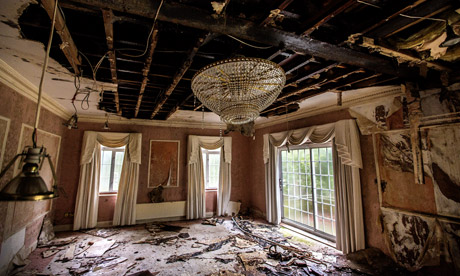 23rd January 2014 - LONDON: The Bishops Avenue.Houses that were bought by the Saudi Royal family in the 1990s and have been now sold. The houses have never been lived in and have been left to rot..Pictured is 'Georgians' on The Bishops Avenue...(Photograph by Graeme Robertson)..abandoned.rotting.urban decay.biavg Photograph: Graeme Robertson
23rd January 2014 - LONDON: The Bishops Avenue.Houses that were bought by the Saudi Royal family in the 1990s and have been now sold. The houses have never been lived in and have been left to rot..Pictured is 'Georgians' on The Bishops Avenue...(Photograph by Graeme Robertson)..abandoned.rotting.urban decay.biavg Photograph: Graeme Robertson
"It used to be the Arabs buying trophy assets but not moving in, but now you have a lot of new money coming in," Panayiotou said. "Over the last 20 years it was the elite that bought these properties and a lot didn't live in them but might come over two or three weeks a year. There was so much money that these houses were being left behind. In the last 10 years people are starting to live in the road."
Firoz Kassam, the former owner of Oxford United Football Club, last year spent close to £30m on three properties which he is planning to turn into three mansions and five apartments. "Everyone wants to be bigger and better than next door so they pull down the buildings and start again," he said. "It has always been like that and it shows no sign of changing." Kassam said to leave houses derelict "is no good for anybody, but it is hard to see what you can do".
Cross the road from the rotting Tower and Jersey House feels a million miles away. The electronic gates swing open on a rebuilt £38m, seven-bedroom mansion with silk carpets and limestone floors. The suited housekeeper turns on ambient music and reveals a six-metre-high hall with shimmering bauble chandelier. A fur is tossed over a chaise longue to create a Downton Abbey ambience.
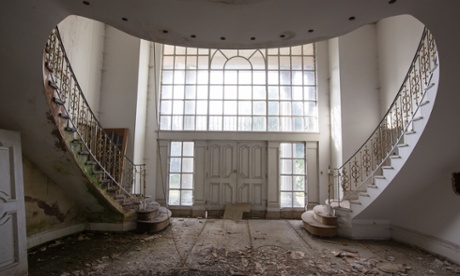 The Towers on The Bishops Avenue. Photograph: Graeme Robertson
The Towers on The Bishops Avenue. Photograph: Graeme Robertson
"Buyers have a celluloid image of Britain in their minds and when they come they want to live the dream," explains Trevor Abrahmsohn, the 59-year-old estate agent who has sold more homes on the avenue than anybody else. "The more things there are that give them instant gratification, the better."
Everything from the leather-clad lift to the vast master bedroom with its three dressing rooms and three bathrooms is "reassuringly expensive" he says. The master bedroom is in fact one bedroom, three dressing rooms (two of which are fitted out in his and hers styles) and three bathrooms. The staff quarters is a self-contained flat that would delight any first time buyer.
In the basement is a swimming pool, gym and spa, while there is a cinema on the first floor and there are two kitchens – one built to catering standard that could serve a small hotel and another more for show. Books are scattered around like heavy hints: The Richest of the Rich and The Villas of the Riviera.
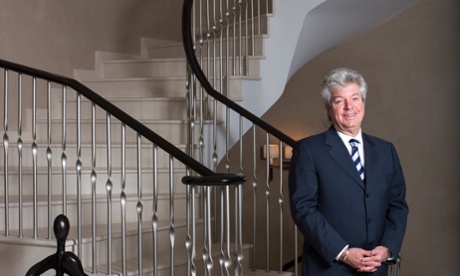 Trevor Abrahmsohn. Photograph: Graeme Robertson
Trevor Abrahmsohn. Photograph: Graeme Robertson
"Everything is extraordinary about it," said Abrahmsohn of The Bishops Avenue. "You can buy a home with multiple acres of land 15 minutes from the centre of London. It is a cross between a dacha and a town house."
The trend for foreign ownership has snowballed to the point that more than half of the 55 properties on the most expensive stretch are now registered to offshore companies or foreign owners. But the prospect of the avenue's empty property being used to help solve the housing crisis remains distant.
A Conservative councillor, Andrew Harper, whose ward covers the avenue, laughed when asked whether some of the derelict housing could become affordable homes. He said the land price would be prohibitive.
"Very wealthy people own property there," he said. "Sometimes they live in them and sometimes they don't". Asked whether leaving homes vacant for decades was acceptable, he replied: "That's their prerogative. It is difficult to imagine what one would put in place to force things to be different to how they are."

